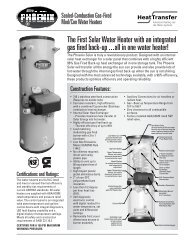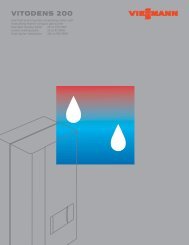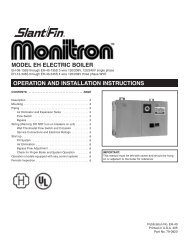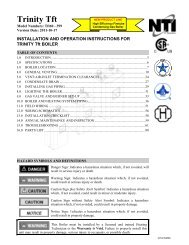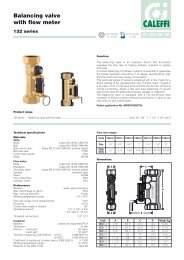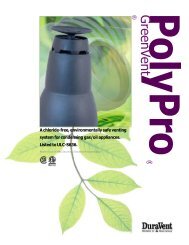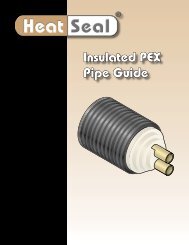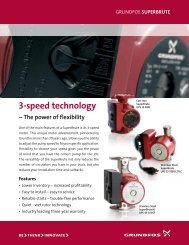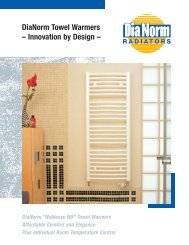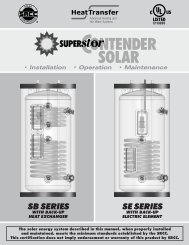Apricus Solar Water Heating System Installation and Operation ...
Apricus Solar Water Heating System Installation and Operation ...
Apricus Solar Water Heating System Installation and Operation ...
You also want an ePaper? Increase the reach of your titles
YUMPU automatically turns print PDFs into web optimized ePapers that Google loves.
<strong>Apricus</strong> <strong>Solar</strong> Collector <strong>Installation</strong> & <strong>Operation</strong> Manual - USAWARNINGSuitable tankless gas water heaters will allow solar heated water to pass straight through ifabove the set temperature. To avoid excessively hot water from reaching the householdtaps <strong>and</strong> potentially causing serious burns, an Anti-Scald Valve MUST be installed after thetankless gas booster to bring the water down to a safe temperature.3.8.3. Boiler Boostinga) Existing Boiler: Many houses have an existing gas/oil/diesel boiler that is used for space heating <strong>and</strong>hot water supply. This can be used to boost the top coil of a twin coil tank or the bottom coil of a secondaryhot water storage tank that is fed by the solar pre-heat tank. A brazed-plate heat exchanger (BPHE) canalso be used to allow boosting of a direct flow tank.b) Controlling Boiler <strong>Operation</strong>: Boiler operation can be regulated by the solar controller using thethermostat function, which activates the circulation pump when the tank temperature drops below a presetlevel. The boiler system may already have its own boosting controls to achieve the same function. Use thecontrol method that will provide the simplest, most reliable <strong>and</strong> safest operation. Refer to the manufacturer’sspecification for the boiler for detailed operation guidelines.c) Flow Control: If a boiler or tankless heater that requires circulation to operate is used, a pump should beselected that can provide a flow rate of 3-4 gallons per minute while overcoming the manufacturer’s listedpressure drop in the heater. The thermostat function of the <strong>Apricus</strong> controller can be used to control thispump. See section 6.6 for details.Refer to <strong>Apricus</strong> system diagrams for reference.3.9. Isolating Parts of Pipinga) Direct Flow: Direct flow system design MUST incorporate both the ability to isolate the solar loop fromthe rest of the water heating system AND to then drain the solar loop empty. This allows maintenance <strong>and</strong>repair of the collector system without shutting down the entire hot water system. Install isolation ball valves<strong>and</strong> drain valves on both the Supply (Flow) <strong>and</strong> Return Lines inside the mechanical room. When isolatingthe solar loop, open the drain valves immediately after isolating the loop, otherwise pressure could build upto dangerous levels. An appropriately piped, pressure relief valve must be installed on the collector side ofthe isolating valves to prevent damage from occurring from unintentional isolation (by the homeowner, etc).b) Closed Loop: A closed loop system is already isolated from the main’s pressure hot water heatingsystem, but the system should also have the ability to isolate the pump so that the whole system does nothave to be drained if the pump is changed. When isolating a single tank system, the isolation valves locatedon the supply <strong>and</strong> return of the pump station should be used.WARNINGWhen isolating any section of pipe it is essential that pressure be released by opening adrain valve or loosening a fitting. Failure to release pressure on an isolated section ofpipe, especially if that includes a solar collector, could result in dangerously high pressures<strong>and</strong> temperatures.3.10. Operating Limitsa) High Temperature Limits: The high temperature limits of all components in the system must be known<strong>and</strong> MUST NOT be exceeded. Any components in close proximity to the collector, especially, on the ReturnLine, can be exposed to 30 or 40 second periods of up to 320°F (160°C) temperatures, when the pump turnsON after stagnation. The following components, in particular, must be high temperature rated, but this listby no means exclusive:- High-point ball valve (used for auto-air vent during system charging)- Pipe insulation (either high temp EPDM or fiberglass)Copyright 2011 – <strong>Apricus</strong> Inc Doc: A7-05.4.1.4-PB-1.9 Page 27 of 126



